- Quick Read
- Deep Read ( 8 Min. )
In Today’s Issue
- Liberal or moderate? Depends which Tim Walz you’re talking about.
- Today’s news briefs
- Michelle Obama raised a big tent – and brought down the house
- As former teacher Tim Walz takes center stage, will education, too?
- Protests over women’s safety in India are taking cues from an unusual source
- How China-Philippines tensions are bringing South China Sea conflict to new brink
- Barcelona is swamped by tourism. Locals are pushing back.
Monitor Daily Podcast
- Follow us:
- Apple Podcasts
- Spotify
- RSS Feed
- Download
TODAY’S INTRO
Where our Gaza reporter is now
 Mark Sappenfield
Mark Sappenfield
Last week, Ghada Abdulfattah evacuated her home. Our correspondent in Gaza has evacuated before, but she’s always been able to move between family homes. This week, she’s experiencing more acutely what so many Palestinians in Gaza have known – placelessness, helplessness, and the hope that something, anything will bring this war to an end.
Her family has atomized to the different corners of Gaza, seeking the promise of safety that shrinks by the day. Now living in a relative’s home – still in an “unsafe” zone – Ghada is seeking a room or a tent to live in.
But there’s nothing left to share. No homes. No tents. People are now using aid blankets as shelter. And I wonder: When is hope exhausted? When are our stores of resilience drained? For The Christian Science Monitor, this is a profound question. We were founded on the principle that spirituality makes these qualities inexhaustible. And yet the situation in Gaza has left Ghada and other innocent civilians in a situation beyond imagination.
Ghada once longed for a cease-fire to rebuild, reconnect, and refresh her spirit. Now she only wishes for one day of mental calm, in which no bombs fall.
Share this article
Link copied.

Help fund Monitor journalism for $11/ month
Already a subscriber? Login

Monitor journalism changes lives because we open that too-small box that most people think they live in. We believe news can and should expand a sense of identity and possibility beyond narrow conventional expectations.
Our work isn't possible without your support.
Liberal or moderate? Depends which Tim Walz you’re talking about.
As Tim Walz speaks at the Democratic National Convention tonight, both campaigns are trying to define him. Mr. Walz himself makes it interesting. His career arc spans from representing rural conservatives to signing bills that move Minnesota leftward.

-
Colette Davidson Special correspondent
In the two weeks since U.S. Vice President Kamala Harris chose Minnesota Gov. Tim Walz as her running mate, both campaigns have been scrambling to shape his public image – for better or worse.
Democrats are painting him as a gun-toting, football-coaching, former National Guard member with a moderate track record and a “Midwestern dad” vibe. Republicans say he’s a radical progressive hiding behind camo, who has spoken misleadingly about his military service and pushed his state far to the left.
One thing allies and critics agree on: Mr. Walz changed between his time as a congressman and his current role as governor, from a centrist politician to a markedly more progressive one.
During his 12 years in the U.S. House, Mr. Walz was ranked as one of the most bipartisan members of Congress, near the center of the ideological spectrum. Then as governor, he shifted left, enacting a slew of progressive priorities: free school lunches, paid family and medical leave, and free college tuition for some students.
When the governor takes the stage at the Democratic National Convention Wednesday evening, it will be the biggest moment of his 20-year political career – and a key opportunity to further define himself in the public eye.
Liberal or moderate? Depends which Tim Walz you’re talking about.
In the two weeks since Vice President Kamala Harris chose Minnesota Gov. Tim Walz as her running mate, both campaigns have been scrambling to shape his public image – for better or worse.
Democrats are painting him as a gun-toting, football-coaching, former National Guard member with a moderate track record and a “Midwestern dad” vibe. Republicans say he’s a radical progressive hiding behind camo, who has spoken misleadingly about his military service and pushed his state far to the left in just a few short years.
One thing allies and critics agree on: Mr. Walz changed between his time as a congressman and his current role as governor, from a centrist politician to a markedly more progressive one.
During his 12 years in the House, Mr. Walz, who represented a red district in southwestern Minnesota, was known as an advocate for rural issues and veterans. He was ranked as one of the most bipartisan members of Congress, near the center of the ideological spectrum.
Then as governor, Mr. Walz shifted left after a crucible of a first term shaped by the COVID-19 pandemic and riots that erupted after a police officer murdered George Floyd, a Black Minneapolis-area resident. He enacted a slew of progressive priorities: free school lunches, paid family and medical leave, and free college tuition for some students.
Republicans argue the shift was driven by ambition, as Mr. Walz’s star began to rise in the Democratic Party. Democrats say it’s simply proof that Mr. Walz – who has a higher favorability rating than Ms. Harris, former President Donald Trump, and Mr. Trump’s running mate, Ohio Sen. JD Vance – is attuned to his constituents and adapts to new circumstances.
When the governor takes the stage at the Democratic National Convention Wednesday evening to accept the vice presidential nomination, it will be the biggest moment of his 20-year political career – and a key opportunity to further define himself in the public eye.
“[Democrats] are going to try to define Walz in terms of his congressional career, because he represented a Republican, rural, conservative district. He was bipartisan and had a lot of friends on both sides of the aisle,” says Vin Weber, a Republican strategist and former Minnesota congressman. “Republicans have to define him by the [2020] Minneapolis riots and 2023 legislative session.”

Multiple election wins in farm country
Minnesota’s 1st Congressional District, in a rural area along the state’s southern border with Iowa, is responsible for more than one-third of the state’s agriculture production. That sets its residents apart from the rest of the state; almost 3 in 4 Minnesotans live in urban areas. While Minnesota has the longest Democratic voting streak in presidential contests of any state in the country, Mr. Walz became only the second Democrat elected from his district since the 19th century when he beat a six-term Republican incumbent in 2006. He then won reelection five times – including in 2016, when Mr. Trump won many counties in the 1st district by double-digit margins.
“Our needs down here are different from what someone needs in Minneapolis or on the Iron Range” in northern Minnesota, says Caitlin Nicholson, chair of the Minnesota Democratic-Farmer-Labor Party in the 1st Congressional District. “A good politician listens to the people he is representing. Any shift from Walz is because he listened to the people.”
Mr. Walz was reportedly first inspired to run for Congress when, while teaching and coaching football in Mankato, he took a group of students to a rally for then-President George W. Bush in 2004. Upset at how some of the students were treated at the campaign rally after security saw one of them with a John Kerry sticker, Mr. Walz decided to volunteer for Mr. Kerry’s presidential campaign. Soon after, Mr. Walz launched a campaign of his own.

Controversy over National Guard exit
After serving for more than two decades in the Army National Guard, Mr. Walz retired in 2005 to focus on his campaign. Republicans, and Mr. Vance in particular, have called the timing suspicious, given that his retirement coincided with news of a possible partial mobilization of the Minnesota National Guard to Iraq. The official orders for Mr. Walz’s unit came two months later. Mr. Walz has said it was time to retire and he was ready to serve his country another way, this time in Washington.
Conservatives have also accused Mr. Walz of misrepresenting his service record. He has periodically referred to himself as a command sergeant major. “Coach to the state champs, teacher of the year, command sergeant major,” stated an ad for Mr. Walz’s 2006 campaign, over photos of him in action. Allies say Mr. Walz simply misspoke and that it’s a matter of semantics: He did serve as a command sergeant major but retired one rank below, as a master sergeant.
Despite being a source of recent controversy, Mr. Walz’s service has shaped his political career.
When he launched his first congressional campaign, against Rep. Gil Gutknecht, Mr. Walz hammered the incumbent Republican for voting against a $1,500 bonus for U.S. troops in 2003 – a measure that ended up failing on a tie vote.
“[Mr. Gutknecht] had never worn a uniform but he was making these anti-veteran votes,” says Matt Barron, a Democratic strategist who focuses on rural races and worked on Mr. Walz’s 2006 campaign. And given that Minnesota’s 1st is a “very strong agriculture district,” Mr. Walz also hit his opponent for voting against local water projects. Running as a Democrat in a longtime Republican district was an uphill battle, adds Mr. Barron, but “these things were handed to Walz on a silver platter – and he took advantage of them.”

Once in Congress, Mr. Walz was appointed to the Committee on Veterans’ Affairs, eventually becoming the ranking member. According to GovTrack, 67% of the bills Mr. Walz sponsored while in Congress were related to the armed forces and national security, and 14% were related to agriculture and food.
“As a veteran, I resent what they’re trying to pull” by accusing Mr. Walz of lying about his service, says Steve Mckeown, a Democrat from a southern Minneapolis suburb whose son lives in Mr. Walz’s hometown of Mankato. “He has worked across the aisle and won in a Republican district. … I think he’s a brilliant pick.”
Minnesotans’ mixed views of Walz
Mr. Mckeown spent last Sunday passing out brochures in Minneapolis’ Minnehaha Park, warning voters about Project 2025, a policy blueprint put together by the conservative Heritage Foundation for the next Republican president. Mr. Mckeown says he’s particularly proud of Mr. Walz’s new financial aid programs for farmers.
A hunter, Mr. Mckeown says he respects Mr. Walz’s support of an assault weapons ban – another issue on which the governor’s politics have evolved.
While serving in Congress, Mr. Walz received funding and several “A” ratings from the National Rifle Association. But after the mass shootings in Las Vegas in late 2017 and at Marjory Stoneman Douglas High School in 2018, Mr. Walz says his views on gun restrictions changed. Shortly thereafter, while running for governor, Mr. Walz cosponsored a bill to ban assault weapons after opposing an assault weapons ban in 2009. “I’ve seen enough of this carnage,” Mr. Walz said at the time. Following his reelection as governor in 2022, when Democrats also won majorities in both houses of the Minnesota legislature, he signed a gun safety measure into law requiring universal background checks.
“I believe people grow and change,” says Terry Fisher, a native of Minneapolis who was hosting a picnic for old friends in Minnehaha Park earlier this week. “It’s good to be open.”
“I respect him for that,” says Vanessa Seng, a Democrat from Inver Grove Heights, south of St. Paul. “He saw what he had to work with and got things done.”
With Democratic control of the state legislature, Mr. Walz got many things done over the past two years – a record both sides have referenced in ads. “[Y]ou don’t win elections to bank political capital,” Mr. Walz wrote on X last year. “You win elections to burn political capital and improve lives.”
In 2023 alone, the governor passed laws to provide free breakfast and lunch to Minnesota students, legalize recreational marijuana use for adults, create a state paid leave program for medical needs and childbirth, provide free tuition at Minnesota universities for students whose families earn less than $80,000, phase out all carbon-sourced electricity in the state by 2040, and protect access to reproductive health, including abortions, statewide.
“These are extreme positions,” says former Minnesota Sen. Paul Gazelka who served as Republican majority leader during Mr. Walz’s first term as governor.
During that first term, “I could push him and we could find a place that maybe all of Minnesota wasn’t thrilled with, but we could all feel like [it] was good government,” says Mr. Gazelka. “I don’t think his country roots reflect where he is politically.”
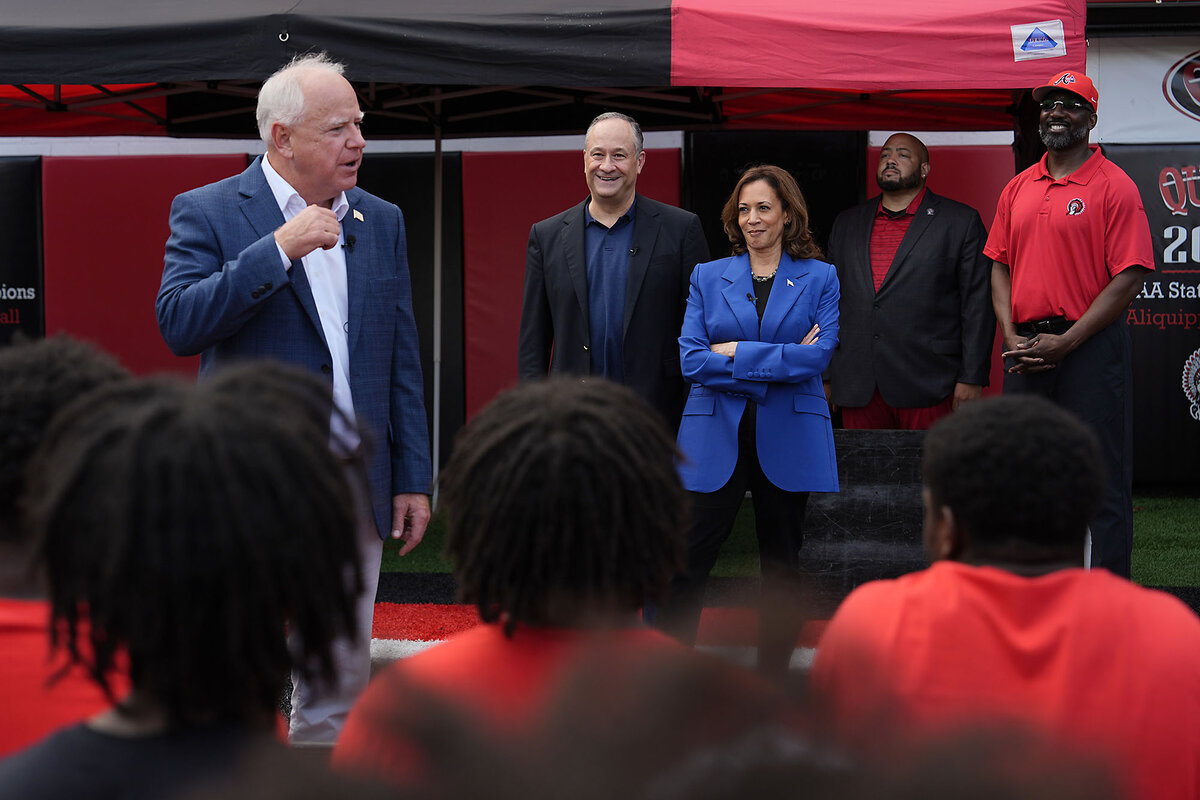
Even in the liberal Twin Cities, where supporters have handwritten “WALZ” on makeshift Harris lawn signs, not everyone is pleased with their governor.
“He’s too liberal,” says Kevin Christian, a Republican who criticizes Mr. Walz for flip-flopping on gun rights and disagrees with several other of his recently passed progressive policies.
Helping Democrats expand their reach?
But to some Democrats like strategist Mr. Barron, Mr. Walz’s progressive politics and country roots make for a powerful combination, allowing him to connect with voters that Democrats have struggled to reach in recent years.
“Republicans have mined rural votes on the cultural, hot-button issues. Where they are vulnerable is the meat and potatoes issues: broadband, agriculture, the Infrastructure Act. This is what rural voters care about,” says Mr. Barron. “Democrats have turned their back on rural America, there is no sugarcoating it. ... You can squeeze the washcloth to get every vote you can out of those urban areas but eventually you max out.”
Mr. Walz can be deployed to these areas and speak authentically, says Mr. Barron. He envisions the campaign sending Mr. Walz to high school football games in rural swing state areas like western Pennsylvania. “If he goes to Friday night lights and the high school football games, if they run an ad in the Erie and Pittsburgh markets with a whistle around his neck with high school kids, that’s really going to resonate.”
The next day, Mr. Walz did just that.
Story Hinckley reported from Richmond, Virginia, and Colette Davidson from Minneapolis.

Today’s news briefs
• Abortion votes: Voters in Arizona and Montana will be able to decide whether they want to protect the right to an abortion in their state constitutions. On Tuesday, the Arizona Supreme Court handed down a ruling that clears the way for the issue to remain on the ballot, and Montana’s secretary of state certified its abortion measure to appear on the ballot.
• China trade war: The Chinese Commerce Ministry says it will launch an investigation into subsidies given by the European Union and EU member countries for milk and cheese products, which could lead to tariffs on their export to China.
• U.K. riots: Pakistan’s police say they have arrested Farhan Asif, a freelance web developer, and charged him with cyberterrorism for his alleged role in spreading misinformation on YouTube and Facebook that led to widespread rioting in the United Kingdom earlier this month.

Michelle Obama raised a big tent – and brought down the house
Michelle Obama electrified the Democratic National Convention with a speech that went beyond the “Yes, we can!” of yesteryear, our cultural commentator writes, while maintaining a focus on hope, dignity, and inclusiveness.

- Quick Read
- Deep Read ( 4 Min. )
When Michelle Obama took the stage at the Democratic National Convention in Chicago to raucous cheering, my mind flashed back to more than a quarter century ago. The setting was also Chi-town when Michael Jordan and the Bulls found themselves in an elimination game and needed a clutch performance to preserve their dynastic empire.
What resulted Tuesday night was one of the more important political commentaries in recent memory. It was also a reminder that Mrs. Obama’s oratorical prowess wasn’t just the envy of political friends, but of foes as well.
Ultimately, her words were far from a “both sides” narrative. They were reflective of the inclusiveness that her political party preaches.
“Look, I don’t care how you identify politically – whether you’re a Democrat, Republican, independent, or none of the above,” she said. “This is our time to stand up for what we know in our hearts is right. To stand up, not just for our basic freedoms but for decency and humanity; for basic respect, dignity, and empathy; for the values at the very foundation of this democracy.”
Michelle Obama raised a big tent – and brought down the house
When Michelle Obama took the stage at the Democratic National Convention Tuesday night in Chicago to raucous cheering, my mind flashed back to a similar crowd and delirious noise from more than a quarter century ago. The setting was also Chi-town when Michael Jordan and the Bulls found themselves in an elimination game against the Indiana Pacers, and needed a clutch performance to preserve their dynastic empire.
Her husband, Barack, would take the stage minutes later, to a similar response. But there was no mistaking who offered the most compelling and “Jordanesque” performance of the night – the “forever first lady.” Former President Obama acknowledged as much, quipping, “I am the only person stupid enough to speak after Michelle Obama,” after the couple embraced on stage.
“There’s something wonderfully magical in the air, isn’t it?” she said. It was an acknowledgment of electricity, the crackling energy in the atmosphere. It reminded me of one of my favorite superheroes, Storm, who has the power to control the weather. For one night, Mrs. Obama embraced a similar command of the political climate, and she gave us the forecast.
What resulted was one of the more important political commentaries in recent memory. It was also a reminder that Mrs. Obama’s speech-delivering prowess wasn’t just the envy of political friends, but of foes as well. Her speech featured familiar themes from the Obama mystique – audacity and hope – while also delivering the counterpunching offense that has been a change in Democratic tactics since Vice President Kamala Harris emerged as President Joe Biden’s replacement.
“It’s the contagious power of hope, the anticipation, the energy, the exhilaration of once again being on the cusp of a brighter day,” Mrs. Obama said. “The chance to vanquish the demons of fear, division, and hate that have consumed us and continue pursuing the unfinished promise of this great nation. The dream that our parents and grandparents fought and died and sacrificed for. America, hope is making a comeback.”
How Michelle Obama rooted hope in personal loss
It was a hope rooted in gravitas, grounded in the loss of a matriarch. Mrs. Obama’s mother, Marian Robinson, died in late May. Mrs. Obama parlayed her personal pain into a rousing endorsement of Vice President Harris that was almost diasporic, noting how even “though our mothers grew up an ocean apart, they shared the same belief in the promise of this country.”
And then, defense turned into offense. It wasn’t simply the fact that Mrs. Obama was unafraid to challenge former President Donald Trump and his “limited, narrow view of the world.” She did so in a way that effectively employed linguistics, which has been the calling card of the Republican Party.
“Woke.” “Critical race theory.” “Liberal.” These terms are considered polarizing in our societal lexicon, if not outright corrosive. But during the course of her speech, Mrs. Obama used Mr. Trump’s making “America great” tagline to promote Vice President Harris’ qualifications.
“Wait, I want to know: Who’s going to tell him that the job he’s currently seeking might just be one of those ‘Black jobs’?” she asked, to uproarious applause.
It was a speech with teeth, and not just the former first lady’s pearly whites. It challenged Mr. Trump’s character and his racial commentary in places such as his interview with the National Association of Black Journalists.
“Look, I don’t care how you identify politically”
It was a message about the relatively short amount of time until November, and what’s at stake during the next 11 weeks. It was a near-perfect speech for a far-from-perfect country, with protests against the U.S. role in the war in Gaza taking place outside.
And yet Mrs. Obama’s commentary was a graduation of sorts. It was more layered than the “Yes, we can!” of yesterday. When “they go low,” going high might not be the best option. Perhaps securing balance is the best response.
Certainly, balance is the thing. Former Rep. Adam Kinzinger and Stephanie Grisham, a former Trump staffer, were part of a quintet of current and former Republicans slated to speak during the convention. It’s hard to imagine conservatives under the same roof as progressive Sen. Bernie Sanders and Rep. Alexandria Ocasio-Cortez, yet there they were, all smiling.
Ultimately, Mrs. Obama’s words were far from a “both sides” narrative. They were reflective of the inclusiveness that her political party preaches.
“Look, I don’t care how you identify politically – whether you’re a Democrat, Republican, independent, or none of the above,” she said. “This is our time to stand up for what we know in our hearts is right. To stand up, not just for our basic freedoms but for decency and humanity; for basic respect, dignity, and empathy; for the values at the very foundation of this democracy.”

As former teacher Tim Walz takes center stage, will education, too?
School choice, civil rights, and a possible Project 2025 agenda are fueling debates in the U.S. about public schooling. How is the undercurrent of education playing out in the 2024 presidential race?

- Quick Read
- Deep Read ( 6 Min. )
For nearly three-quarters of Americans, the economy ranks as their No. 1 issue heading into this year’s presidential election. But 79% of Black voters say improving education should be a top priority for policymakers – higher than any other issue, according to the Pew Research Center.
The U.S. presidential candidates haven’t given education top billing in campaign speeches – at least, not yet – but it’s lurking around the edges in nationwide debates about vouchers, book banning, civil rights, and the potential conservative agenda of Project 2025. On top of that, Vice President Kamala Harris tapped Minnesota Gov. Tim Walz, a former teacher and the headliner at the Democratic National Convention tonight, as her running mate.
All of that “raises the specter” of education in this election cycle, says Kathryn E. Wiley, an assistant professor at Howard University. “It’s an in-the-wings issue,” she says.
Rebecca Dirks Garcia, a registered nonpartisan and mother in Las Vegas, will be paying close attention to what the contenders say. The economy ranks high on her concern list, she says, with education close behind.
“If kids don’t get educated,” she says, “that means we have adults who aren’t educated and then as a society we bear that burden.”
As former teacher Tim Walz takes center stage, will education, too?
Voters say they want lower grocery prices and a more affordable cost of living. Where do schools fall on their wish list? It depends on who you ask.
For nearly three-quarters of Americans, the economy ranks as their No. 1 issue heading into this year’s presidential election. But 79% of Black voters say improving education should be a top priority for policymakers – higher than any other issue, according to a Pew Research Center report.
The presidential candidates haven’t given education top billing in campaign speeches – at least, not yet – but it’s lurking around the edges in nationwide debates about vouchers, book banning, civil rights, and the potential conservative agenda of Project 2025. On top of that, Vice President Kamala Harris tapped Minnesota Gov. Tim Walz, a former teacher and the headliner at the Democratic National Convention tonight, as her running mate.
All of that “raises the specter” of education in this election cycle, says Kathryn E. Wiley, an assistant professor of education at Howard University. “It’s an in-the-wings issue,” she says.
How is education being discussed in the 2024 presidential race?
The post-pandemic years in public education have been defined by academic concerns such as high absenteeism rates and students’ lackluster reading and math skills. Cultural issues, however, have in some ways overshadowed those challenges as clashes over student reading material, history lessons, biblical teachings, and LGBTQ+ rights have erupted across the country.
Now, that rhetoric is spilling over into presidential campaigns. Conservatives, including those from former President Donald Trump’s camp, have slammed a Minnesota law signed by Mr. Walz, arguing that it promotes offering menstrual products in boys’ restrooms. The law does not denote gender, instead calling for the availability of free supplies in restrooms used by fourth through 12th grade students. Still, a #TamponTim hashtag has gained steam on social media.
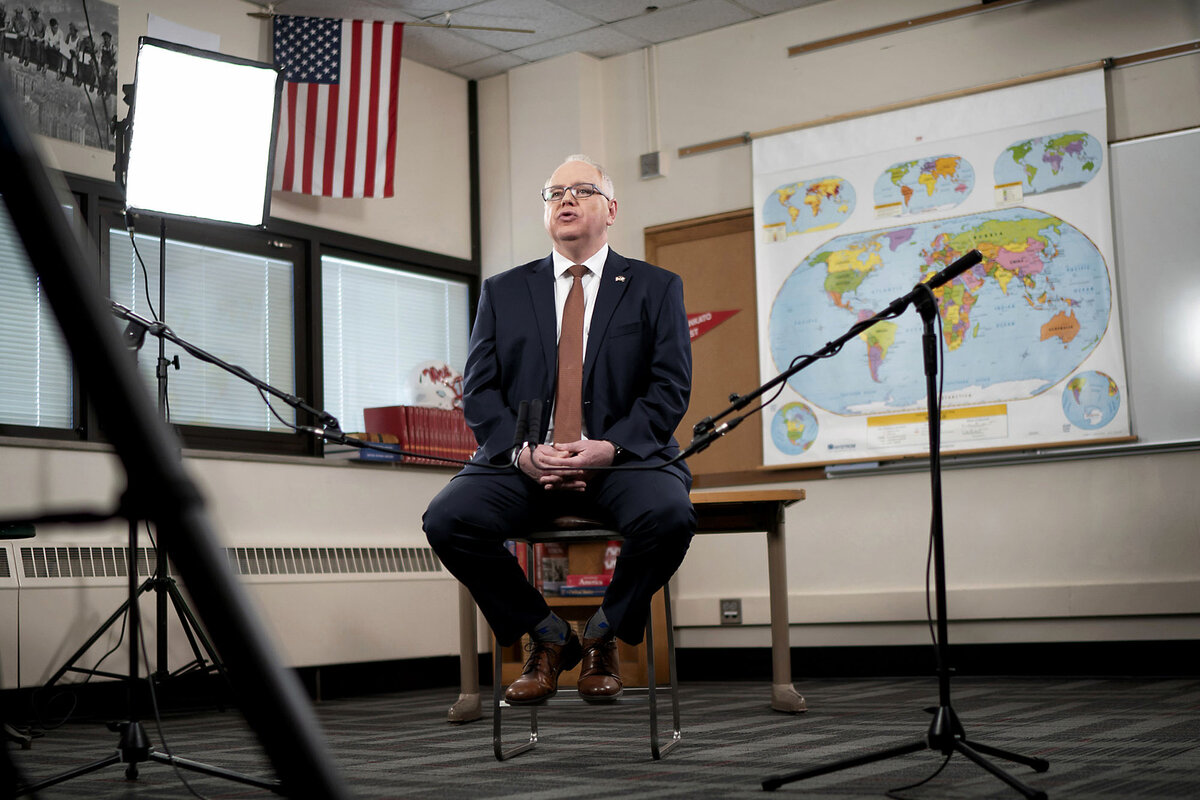
What does that mean for education policy on the federal stage? Perhaps not much, according to Jonathan Becker, associate professor of educational leadership at Virginia Commonwealth University, who teaches a course on politics and education.
He doesn’t expect most of the hot-button education issues to become serious election factors. Take book bans, for instance.
“They may use it kind of rhetorically as part of a campaign, but, ultimately, there’s not really much that can be done at the federal government level around those things,” Dr. Becker says.
Still, they’re certainly weighing on the minds of voters – even if not a driving force like pocketbook issues, immigration, and reproductive rights.
“I think that if Trump gets in, we lose our education freedoms to teach great books and great literature,” says Sharon Cantwell, a middle school teacher in New York who has primarily voted for Republicans. She and her husband – in Las Vegas to celebrate their 40th wedding anniversary – spontaneously decided to attend a recent Harris-Walz rally in the swing state.
Education is widely considered a state and local issue, especially from a money standpoint. Federal funding for K-12 education hovers around 10%, largely to help schools serve students with disabilities or those from disadvantaged backgrounds.
But the Heritage Foundation’s Project 2025 calls for the elimination of the federal Department of Education, thrusting school-related issues into the election spotlight. Mr. Trump has tried to distance himself from the conservative blueprint despite many former aides and allies crafting it. (Mr. Trump’s running mate, Ohio Sen. JD Vance, has written a foreword for a forthcoming book by a leader of Project 2025, called “Dawn’s Early Light: Taking Back Washington To Save America.”)
And yet, the former president doubled down on abolishing the Education Department when Elon Musk interviewed him on an X livestream last week.
Dr. Wiley at Howard hopes the fate of the Education Department garners more attention, particularly to help explain its function to voters.
“If we lost the Department of Education, that would be terrible,” she says. “It’s a significant way that we can enforce and monitor civil rights in education and provide limited funding and support for students.”
Eliminating the Education Department may be a catchy campaign slogan, but doing so would be more complicated. A scholar from the conservative American Enterprise Institute doesn’t anticipate it becoming a reality, even if Mr. Trump inhabits the Oval Office again.
“Somebody will introduce a bill to abolish it, and it will go nowhere because you’re not going to find 60 votes for it in any projectable constellation of the political dynamic,” says Max Eden, a senior fellow at AEI.
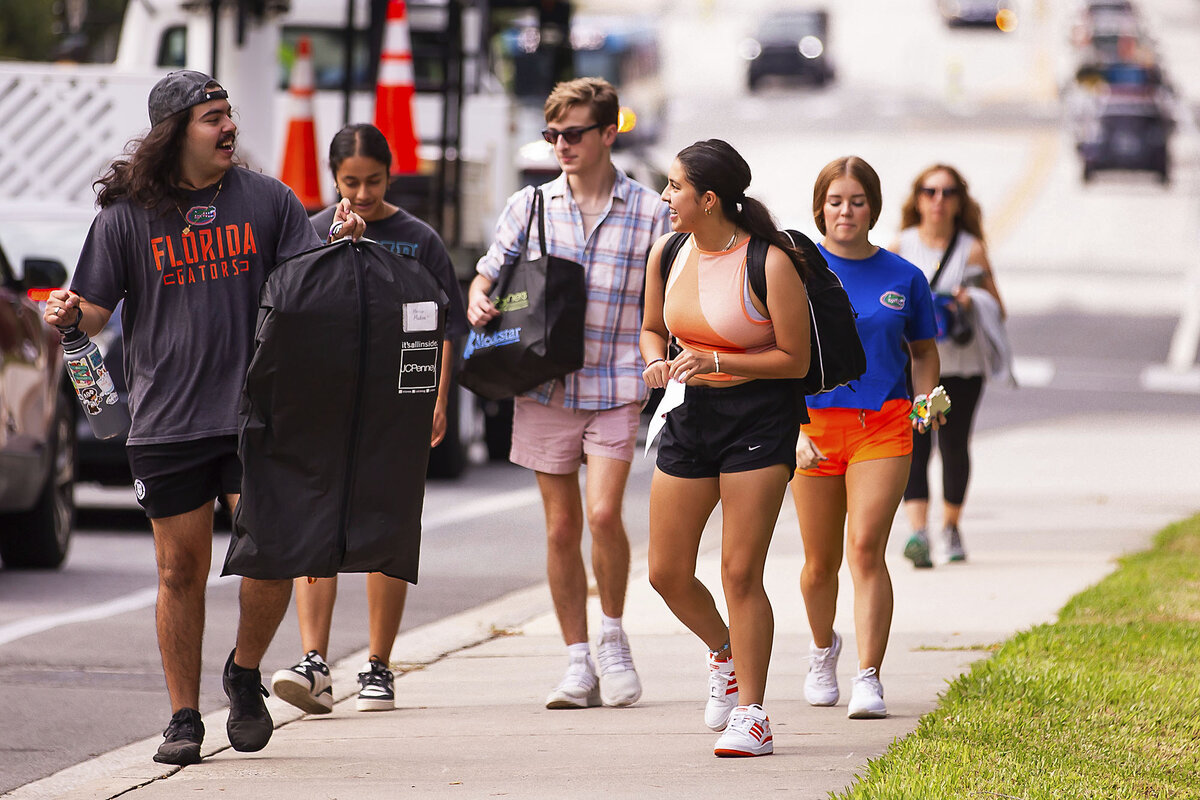
Issues to watch: child care and student loan debt
It may be that issues related to education, such as child care and student loan debt, will get bigger play this election cycle. That’s because candidates will likely try to woo working-class voters, says David Damore, a political science professor and executive director of The Lincy Institute and Brookings Mountain West at the University of Nevada, Las Vegas.
Evidence of that occurred at the recent Harris-Walz rally in Las Vegas. The campaign selected local teacher Tillie Torres to introduce the candidates inside a nearly packed college arena.
In doing so, Ms. Torres plugged the student loan forgiveness she received through the Biden administration, calling it her ticket to “financial freedom” after years racking up interest that eventually surpassed the initial loan amount.
Democrats’ changes to the student loan system could amount to a “sea change in the way that colleges are financed,” Mr. Eden says, which is why he would like to hear more from the Trump campaign about the issue. President Joe Biden’s Saving on a Valuable Education (SAVE) Plan, which lowers repayments based on income and offers some outright forgiveness, has been halted by a federal court.
“Is there an alternative proposition that Trump or the Republicans might offer?” he says. “What will happen with FAFSA [Free Application for Federal Student Aid] over the next year?”
Teachers energized by former educator Walz
Still, Ms. Torres’ message appeared targeted to a considerable voting bloc – her more than 3 million peers teaching in public schools. The mere presence of former educator Mr. Walz on the ballot has energized this key constituency.
Cory Hulsizer, a teacher in Pennsylvania’s Camp Hill School District, welcomes Mr. Walz’s inclusion on the ballot given the “framework” his years as an educator provided. “It is understanding truly the things that kids need to be successful and thrive – and understanding that not on kind of just like a surface level, but seeing that day to day,” says Mr. Hulsizer, who teaches seventh-grade world history and Advanced Placement Government and Politics classes. He cited Governor Walz’s signing a law providing free breakfast and lunch in schools as one example.
Jona Jones, a reading specialist at a Las Vegas elementary school, says Mr. Walz’s selection as the nation’s next potential vice president was “huge.”
“There is an understanding there of where we have been in education and where the rest of the world is as far as education is concerned,” says Ms. Jones, who attended the rally with her father, a retired teacher.
Not everyone buys the notion that Mr. Walz’s inclusion will radically change voters’ minds or the trajectory of public education. That includes the Clark County Education Association, a local teachers union for the Las Vegas-area school district.
“We’re not saying [Mr. Walz is] bad on education,” says John Vellardita, executive director of CCEA. “… But we don’t fall for that schtick that ‘Oh great, we’ve got one of ours up there.’ He’s a career politician.”
The better barometer, he believes, is looking at what the Biden administration has done at the federal level and what Trump’s team, including former Education Secretary Betsy DeVos, did during his presidency. (The Clark County Education Association plans to make an endorsement in the presidential race but has not done so yet. The two largest national teacher unions – the National Education Association and the American Federation of Teachers – endorsed Ms. Harris for president in July.)
Rebecca Dirks Garcia, a registered nonpartisan and single mother of three teenagers in suburban Las Vegas, will be paying close attention to what the presidential contenders say about education. The economy ranks high on her concern list, she says, with education inextricably linked and close behind.
“If kids don’t get educated, that means we have adults who aren’t educated,” says Ms. Dirks Garcia, who runs a Facebook group for parents of Clark County School District students. “And then as a society we bear that burden.”

Protests over women’s safety in India are taking cues from an unusual source
India has long struggled to tackle gender-based violence. But as Kolkata reels from a brutal attack on a young doctor, some protesters point to neighboring Bangladesh as proof that with enough solidarity, change is possible.

- Quick Read
- Deep Read ( 4 Min. )
-
By Sarah Aziz Contributor
The rape and killing of a trainee doctor at the state-run R.G. Kar Hospital in Kolkata, India, has sparked outrage across the country.
Protesters in Mumbai, Delhi, and other cities are demanding a transparent investigation and improved safety measures at government hospitals, as well as expressing frustration at India’s lack of progress on women’s safety over the past decade. Doctors have gone on strike, refusing to treat nonemergency patients.
And back where it all started – in the state of West Bengal – protests continue to grow, with organizers drawing inspiration from neighboring Bangladesh. Across the border, student protests over job quotas ballooned into a movement against the government’s autocratic tendencies, successfully ousting the country’s long-ruling prime minister earlier this month.
West Bengal’s head of government is now under intense scrutiny for mistakes her administration allegedly made early on in the R.G. Kar case, including failing to secure the crime scene and cracking down on student protests. Many are calling for her to resign.
University of Calcutta senior and demonstrator Sanhita Sarkar has drawn courage from the Bangladeshi protesters, who she says “joined hands to go against the unfair treatments of their government and ... snatched away what they deserved – freedom.”
Protests over women’s safety in India are taking cues from an unusual source
For University of Calcutta senior Sanhita Sarkar, there was little to celebrate on India’s recent Independence Day.
The brutal rape and killing of a trainee doctor at the state-run R.G. Kar Hospital in Kolkata had sparked mass protests throughout the city, and as she joined thousands of other women carrying signs and blazing torches that evening, Ms. Sarkar wondered: Will the women of India ever truly be free?
The “Reclaim the Night” march was a call for justice and systemic change in a country that has long struggled to control rampant violence against women. It is a call that has echoed across India in the week since.
Protesters in Mumbai, Delhi, and other cities are demanding a transparent investigation and improved safety measures at government hospitals, as well as expressing frustration at the lack of progress on women’s safety. Doctors have gone on strike, refusing to treat nonemergency patients. On Tuesday, India’s Supreme Court established a task force to address hospital safety, but many say it’s not enough.
And back where it all started – in the state of West Bengal – protests continue to grow, with organizers drawing inspiration from neighboring Bangladesh. Across the border, student protests over a controversial job quota system ballooned into a broader movement against the government’s autocratic tendencies, successfully ousting the country’s long-ruling prime minister earlier this month.
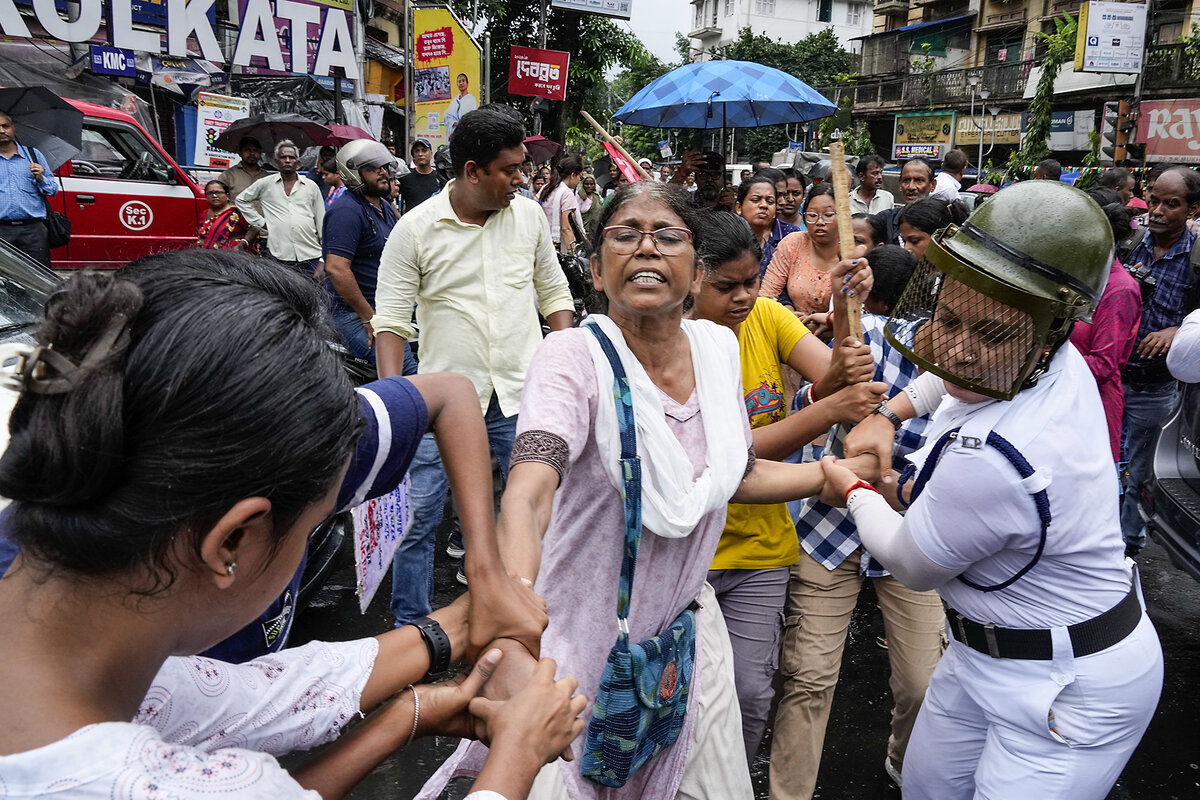
Ms. Sarkar says that she felt the need to “imbibe the courage of the common people of Bangladesh” when she marched on Aug. 15.
“The youth of Bangladesh joined hands to go against the unfair treatments of their government and ... snatched away what they deserved – freedom,” she says. “The hope, the unity, the faith that Bangladesh showed simply gives more strength and power to the citizens of West Bengal.”
The Kolkata protests are unlike anything the state has ever witnessed, says Sreyasi Chatterjee Banerjee, a sociology professor specializing in gender at Prasanta Chandra Mahalanobis Mahavidyalaya, a college in Kolkata.
What began as targeted demonstrations among medical staff and students, primarily over hospital safety, have expanded to encompass many sectors of society – similar to the Bangladesh protests, which spread after security officials killed unarmed student protesters.
Now, the head of West Bengal’s government, Chief Minister Mamata Banerjee (of no relation to the professor), is under intense scrutiny for mistakes allegedly made by her administration and Kolkata police early on in the R.G. Kar case, including failing to secure the crime scene, initially downplaying the victim’s death as a suicide, and cracking down on student protests. Many are calling for her to step down.
In a viral video this week, one of Ms. Banerjee’s ministers was heard pushing back on her critics, vowing that “we will never allow West Bengal to turn into another Bangladesh.”
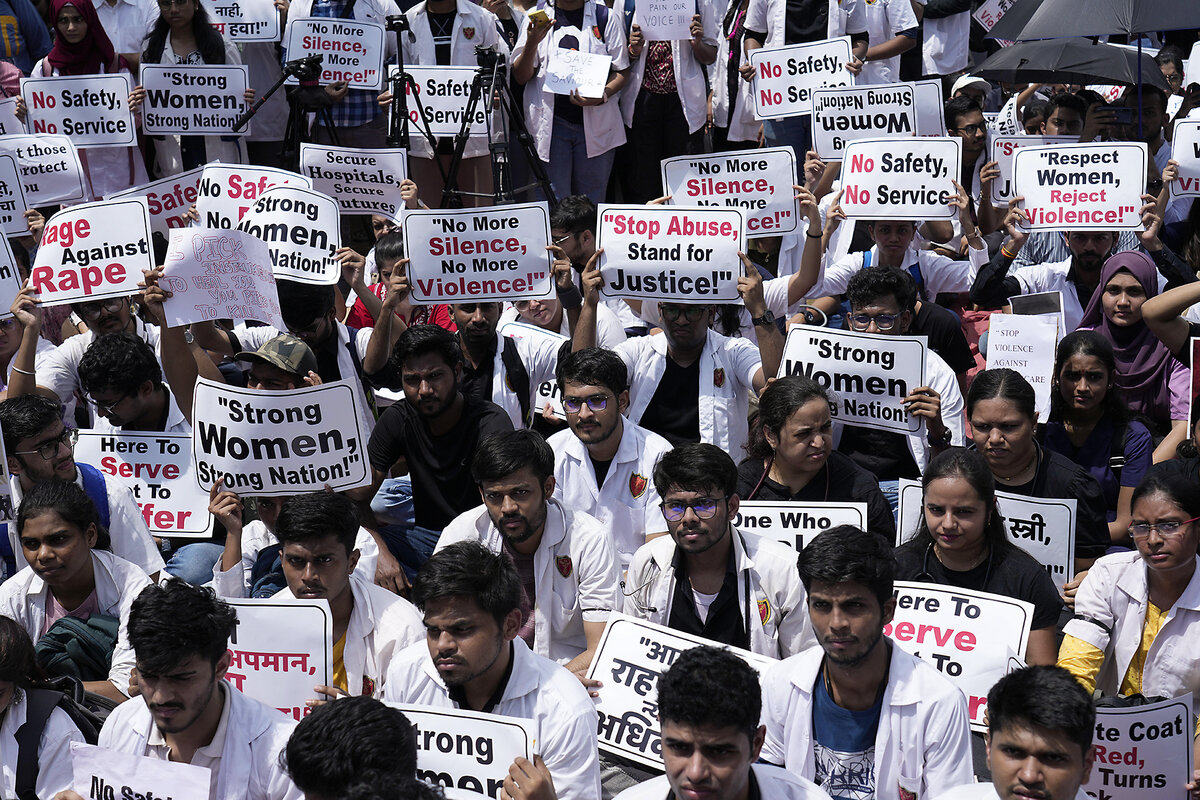
Bangladesh comparisons aside, this isn’t the first time India has erupted over violence against women.
The 2012 gang rape of a young woman on a New Delhi bus sparked nationwide protests, and prompted Indian authorities to introduce stricter anti-rape laws. Yet activists and gender-based violence experts say that when it comes to the safety of women and other gender minorities, India hasn’t moved the needle much.
“If we go by the book, then a lot has changed since 2012,” says Professor Banerjee. “But in reality, the general public are not sensitized enough, and know little about the modifications of the anti-rape laws.”
That lack of awareness was underscored by a wave of social media users encouraging people to share the R.G. Kar doctor’s name and photograph – an activity that may may not be malicious but violates Section 228A of the Indian Penal Code, which forbids revealing a rape victim’s identity.
“They are revealing every tiniest detail” about the case, she says.
Indeed, some activists say that if the last 12 years have revealed anything, it’s how deeply ingrained gender-based violence is in Indian society.

According to the National Crime Records Bureau in India, an average of 86 rapes per day were reported nationwide in 2022, the most recent year for which data is available. Given the stigma around reporting rape, the actual number of attacks is believed to be much higher.
“Each and every girl I know has been molested in her life at least once,” says Kolkata-based lawyer Shafqat Rahim, who participated in the Aug. 15 “Reclaim the Night” protest and other demonstrations. “This has been normalized in this male-dominated society. We are fighting against ... a culture which promotes rape.”
But the Bangladesh protests have inspired many in Kolkata to believe that change is possible, even in the face of biased laws or unfair systems. Their success “is one of the reasons why many of the students [in Kolkata] who [previously] considered themselves apolitical are also participating in this movement,” Ms. Rahim says.
That inspiration flows both ways. In Bangladesh’s capital, Dhaka, students returned to the streets last week, with young women at the forefront, to march in solidarity with Kolkata.
“The issue of the R.G. Kar rape and murder resonates deeply with us,” says Tasneem Zaman Labeeb, a Dhaka University student. “For years, we have witnessed the brutalities inflicted on women in Bangladesh and observed how the state often acts to protect the perpetrators. The parallels in how the state apparatus covers up one crime, leading to a cascading effect, are strikingly similar.”

The Explainer
How China-Philippines tensions are bringing South China Sea conflict to new brink
China’s expansions in the South China Sea are shifting power dynamics in the valuable, disputed waterways, complicating efforts to maintain peace.

- Quick Read
- Deep Read ( 5 Min. )
Chinese and Philippine coast guard ships collided Monday near Sabina Shoal in the South China Sea, causing damage to at least two ships. Beijing and Manila have blamed each other for the incident.
It’s a new flashpoint in the conflict over a 1.4 million-square-mile sea prized for its vital shipping lanes and rich fish stocks, as well as oil and gas resources. China and the Philippines have overlapping claims in the South China Sea, including over the Sabina Shoal, which lies inside the Philippines’ exclusive economic zone. China has rejected a 2016 United Nations ruling that found its claims in Philippine waters unlawful.
Despite recent efforts by both sides to cool tensions, this week’s collision brings the territorial dispute to a new and dangerous brink.
Over the past decade, China has accelerated its efforts to enforce its expansive territorial and jurisdictional claims to most of the South China Sea. Today, it is able to maintain a continual military proximity to disputed areas that dwarfs that of smaller claimants, including Vietnam, the Philippines, and others.
“China really sets the tone,” says Ian Storey, senior fellow at the ISEAS-Yusof Ishak Institute in Singapore and an expert in Asian security. “When China is more assertive, tensions go up.”
How China-Philippines tensions are bringing South China Sea conflict to new brink

Chinese and Philippine coast guard ships collided this week in a fresh clash between the Asian superpower and its neighbor in the South China Sea. The escalation of the territorial dispute in the strategic waterway has brought China and the Philippines – a U.S. treaty ally – to a new and dangerous brink, despite recent efforts by both sides to cool tensions.
Reportedly the first direct skirmish between the two sides at Sabina Shoal in the sea’s Spratly Islands archipelago, the incident marks an expansion of a long-simmering conflict that has worsened over the past year, due largely to China asserting its expansive claims over the South China Sea.
“China really sets the tone,” says Ian Storey, senior fellow at the ISEAS-Yusof Ishak Institute in Singapore and an expert in Asian security. “When China is more assertive, tensions go up.”
What happened in the latest clash, and what is at stake?
On Monday, coast guard vessels of China and the Philippines crashed into one another near Sabina Shoal, causing damage to at least two of the ships, according to statements from each government. Beijing and Manila blamed each other for the collision, and reported no injuries to crew members.
It’s a new flashpoint in the conflict over a vast, 1.4 million-square-mile waterway stretching from southern China and Taiwan to the Philippines, mainland Southeast Asia, and Indonesia. The South China Sea is valued for its vital shipping lanes, rich fish stocks, and coral, as well as oil and gas resources; the area contains an estimated 11 billion barrels of oil reserves, and 190 trillion cubic feet of natural gas.
China and the Philippines have overlapping claims in the South China Sea, including over the Sabina Shoal. The disputed atoll lies inside the Philippines’ 200-nautical-mile-wide exclusive economic zone as defined by the 1982 United Nations Convention of the Law of the Sea. A 2016 arbitration ruling by an UNCLOS tribunal found that China’s claims, land reclamation, and other activities in Philippine waters were unlawful. But China has refused to abide by the ruling, rejecting it as “null and void.”

Monday’s collision follows a violent skirmish in June that injured a Filipino sailor near another feature of the Spratly Islands archipelago, Second Thomas Shoal. Manila has an outpost there on a beached Philippine warship. After that incident, Beijing and Manila held talks and came to an unpublicized agreement over the Philippines’ resupply missions.
“They ... pulled back,” says Dr. Storey. “Both sides realize that if they continued ... it would have raised the risk of a clash, possibly leading to fatalities.”
Manila this week reiterated that it prefers diplomacy to address the ship collisions. Still, he adds, “It’s unclear how long that agreement will remain in place.”
How has China “set the tone” in the South China Sea?
Over the past decade, China has accelerated its efforts to enforce its expansive territorial and jurisdictional claims to most of the South China Sea.
China claims a majority of the strategic waterway using a vaguely defined “nine-dash line” that extends deep into the exclusive economic zones of other claimants including the Philippines, Vietnam, Malaysia, Brunei, and Indonesia. It has beefed up this effort despite the 2016 UNCLOS ruling that held its “nine-dash line” had “no legal basis.”
China has built artificial islands in the Spratly chain and militarized them, building runways and deploying advanced anti-ship and antiaircraft missile systems. These outposts have allowed China to bolster its military and paramilitary presence in the South China Sea, using its rapidly expanding coast guard fleets to gain de facto control.

How have smaller claimant nations responded?
Unlike in past decades, China today is able to maintain a continual military proximity to disputed areas of the South China Sea that dwarfs that of other claimants. “There is a huge asymmetry of power,” says Dr. Storey. “The Southeast Asian claimants can’t really stand up to China in any military way, so they ... continue to protest China’s activities, [and] to monitor.”
Vietnam, for example, was able to occupy several land features in the Spratly Islands chain in the 1980s before China’s rise, allowing it to maintain a small but effective force in the area, experts say.
In recent years, the Philippines has gained stronger intelligence capabilities for monitoring the Chinese coast guard, and it’s also establishing a foothold on some islands from which it can mount more rapid, shorter-distance patrols.
Smaller claimants also engage in consultations with China to ease tensions – as the Philippines has done recently. Yet while such talks can help reduce the possibility of violent conflict, they are unlikely to achieve a fundamental resolution of the territorial disputes, experts say.
What can the United States do to support allies and counter China’s aggression?
The U.S. State Department on Monday condemned “dangerous and escalatory” actions by China against “lawful Philippine maritime operations” and said it stands with its ally the Philippines. It reaffirmed Article IV of the 1951 U.S.-Philippines Mutual Defense Treaty, noting that it includes attacks on the Philippine coast guard anywhere in the South China Sea.
The United States makes no territorial claim in the South China Sea, and advocates for the peaceful resolution of disputes on the basis of international law. It does have vital interests in keeping the sea lanes open, and the U.S. military conducts regular “freedom of navigation” patrols in the South China Sea to challenge what Washington considers excessive maritime claims.
Still, some experts say the U.S. could do more to push back on China’s growing assertiveness in the South China Sea, without being provocative.
Diplomatically, the U.S. could organize talks among Southeast Asian states to promote agreement over the rights granted by controlling land features, says Oriana Skylar Mastro, a Center Fellow at the Freeman Spogli Institute for International Studies at Stanford University.
Militarily, the U.S. could expand its treaty commitments to cover support for operations within the exclusive economic zones of treaty allies. It could also mount selective, occasional military escort missions together with allies such as the Philippines in the South China Sea. “The United States doesn’t have to escort every single ship,” says Dr. Mastro, author of “Upstart: How China Became a Great Power.” “We can reserve the right to do it, and do it periodically, especially when things are under fire.”


Barcelona is swamped by tourism. Locals are pushing back.
Tourism is making some of the world’s great tourist destinations unlivable for their own residents. Places like Barcelona are trying to find a balance between affordability for locals and welcoming accommodations for guests.

- Quick Read
- Deep Read ( 5 Min. )
-
Nick Squires Special contributor
In hot spots around the world, including the Mediterranean, residents say they have reached a tipping point as tourism has reached new post-pandemic heights. Mass tourism, they say, is overwhelming public spaces, driving up housing prices and pushing locals out, and turning neighborhoods into exhibits on display.
“There are many vendors here who have turned only to tourism,” says María Carmen Pujadó, who works in Barcelona’s oldest market. Once a neighborhood hub where locals came to buy produce, fish, and meat, the Mercat de la Boqueria now caters to tourists, offering smoothies, potato chips, and other globalized items.
In June, in a bid to ease Barcelona’s housing crisis, Mayor Jaume Collboni announced an end to the city’s 10,000 tourist rental apartments by 2028. Tourists staying in overnight accommodations reached nearly 10 million in 2023, up 15% from the previous year. A 2023 study found that 62% of Barcelonans say the city is near or at its capacity for tourism.
“The excesses and the problems of tourism have entered into people’s daily lives much more than before,” says anthropologist Claudio Milano. The issue is not the number of tourists, he says. “It’s the weight of tourism in our economy.”
Barcelona is swamped by tourism. Locals are pushing back.

Most hot summer days, Barcelona locals avoid La Rambla if they can. It’s too crowded, with tourists cramming the famous, tree-lined avenue as they take in some of the most-visited sites in the world: the Sagrada Família cathedral, the Gothic Quarter, the Barceloneta beach.
But on a recent Saturday afternoon, it is the tourists who are pushed aside as residents take over the boulevard.
They gather in the thousands to reclaim a city they say they have lost to tourism. “Barcelona is not for sale!” reads one banner in English. “Tourism kills the neighborhood,” reads another in Catalan.
Tourists take photos of the crowd from balconies and alleyways. Some have to dodge the spray of toy water guns pointed at them by protesters shouting, “Tourist, go home!”
In hot spots around the world, including the Mediterranean, residents say they have reached a tipping point as tourism has reached new post-pandemic heights. Many are protesting a model of mass tourism they say overwhelms public spaces, drives up housing prices and pushes locals out, and turns neighborhoods into exhibits on display.
“The excesses and the problems of tourism have entered into people’s daily lives much more than before,” says Claudio Milano, an anthropologist at the Autonomous University of Barcelona. That happens when a place becomes overly dependent on the tourism industry, and local economies are restructured to meet the needs of visitors rather than of residents.
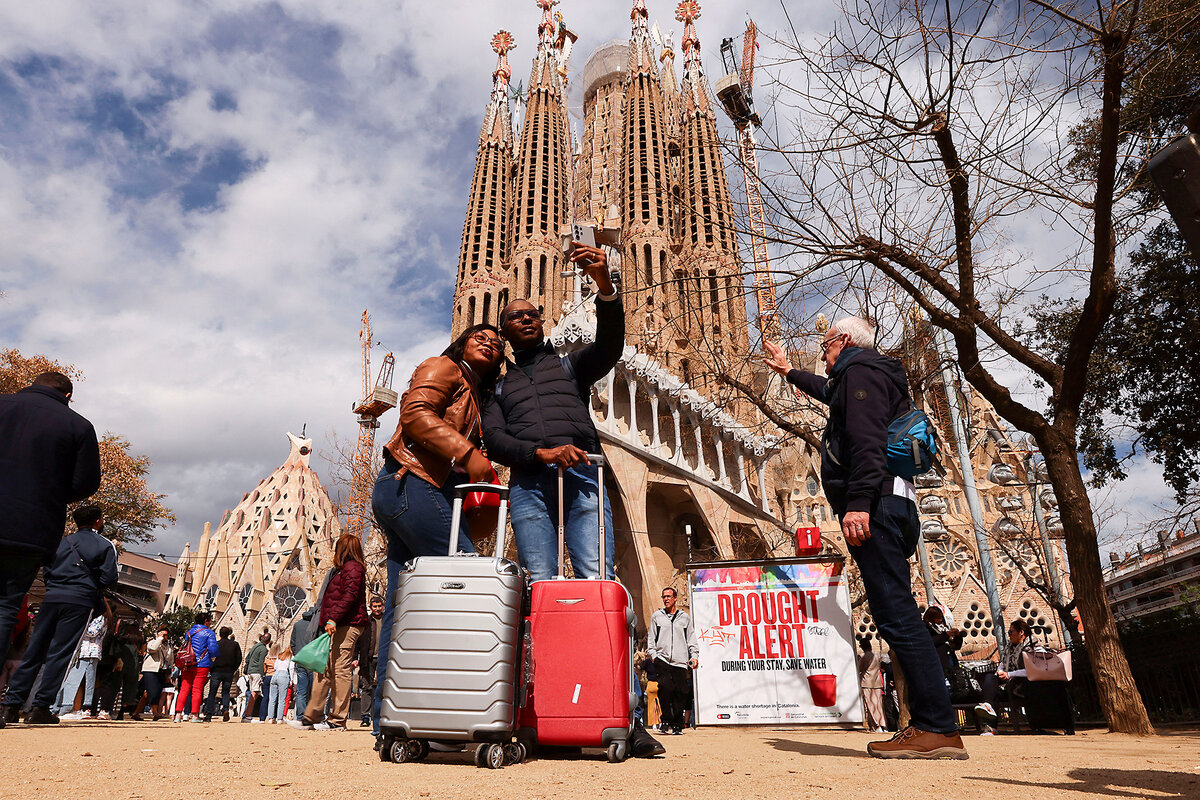
The issue is not the number of tourists, he says. “It’s the weight of tourism in our economy.”
The business of tourism
Over the course of a lifetime, María Carmen Pujadó has watched her city’s oldest market, which dates back to 1217, transform around her.
Once a neighborhood hub where locals came to buy produce, fish, and meat, the Mercat de la Boqueria is now a sightseeing attraction. Vendors sell smoothies, potato chips, chicken tenders, and other globalized items ready for tourists.
Ms. Pujadó inherited her olive and canned goods stand from her parents and spent most afternoons here as a child, watching her father banter with regulars. Every year, she says, these longtime customers disappear.
“There are many vendors here who have turned only to tourism,” adds Ms. Pujadó. Her stand straddles the old world and the new. Behind her is a display of canned fish and goods tourists never touch, she says. Up front, she sells skewers of olives tourists eat on the spot.

“I have to maintain the few customers I’ve had my whole life,” she says. “But of course I have to put things out for tourists as well.”
It’s a balance cities around the world are struggling to find.
In June, in a bid to ease Barcelona’s housing crisis, Mayor Jaume Collboni announced an end to the city’s 10,000 tourist rental apartments by 2028. Tourists staying in overnight accommodations reached nearly 10 million in 2023, up 15% from the previous year. A 2023 study found that 62% of Barcelonans say the city is reaching or has reached its capacity for tourism, though 71% believe tourism is beneficial for the city.
“Our objective is not to knock out tourism,” says Karen Pratt, a longtime Barcelona resident originally from the United States, as she marches with other protesters. “It’s an important part of our economy, but it should not be the most important part.”
That would mean reversing a process of deindustrialization that began in the 1960s and has intensified along with globalization, says Ernest Cañada, a postdoctoral researcher at the University of the Balearic Islands. It would also mean moving investment away from the tourism industry, which he says tends to create precarious and seasonal jobs.
Destinations around the world are trying to find ways to ease tourist pressure, too. Earlier this spring, Japan opened a paid reservation system for visitors to Mount Fuji, while a nearby town is building a screen to block the view of the famous mountain. Amsterdam has banned the construction of new hotel buildings. Venice, Italy, implemented a €5 entry fee to the city last fall. Copenhagen, Denmark, is trying out a carrot rather than a stick approach. A new pilot program gives rewards to tourists who act sustainably, from collecting trash to biking and using public transport.

“The problem isn’t tourism,” says Dr. Cañada. “It could be tourism, it could be mining. The problem is the overdependence on any one economic activity.”
Other extractive industries like fishing and forestry are regulated, points out Pere Mariné, a representative of the Federation of Neighborhood Associations of Barcelona. “This is at least as important, because it’s people’s lives.”
Finding a middle ground on tourism
A little more than 100 miles off the coast of Barcelona, on the Balearic Islands, residents say they are facing collapse. This summer, islanders have staged sit-ins on their own beaches, cramming together on towels to demonstrate their frustration with feeling squeezed out by tourists.
“I understand that we need tourism – I work at the airport,” says Marina Vaquer. “But we cannot handle the current numbers. We feel nowadays that we don’t have any space in our own home.”
Zoltan Langhaus, a teacher from Germany visiting Mallorca on holiday, says he can understand why it feels like too much. “I’m from Berlin and we have similar problems,” he says.
Teachers, waiters, and others often cannot afford to live on the island with their salaries. According to the property website Fotocasa, the average rent for a small apartment in the Balearic Islands has almost tripled over the past decade. But with tourism making up 45% of the island’s gross domestic product, reducing the island’s dependency is no easy task.
Back in Barcelona, Sebastián Ramírez steps out of his front door onto La Rambla, the avenue as cramped as ever. As a walking tour guide, he appreciates visitors who come to learn about the city and its history. But even he says the city has reached its limit, and is considering moving out of the city center.
“Tourism is easy money. You already have the city, the infrastructure. It’s very tempting,” he says. Yet today he and his neighbors are asking themselves new questions.
“What is the middle ground of how to survive? How can we live in a sustainable economy where we all live well without having to resort to extremes? Because all this is disproportionate.”
Other headline stories we’re watching
(Get live updates throughout the day.)The Monitor's View
Solar-powered peace in Asia
- Quick Read
- Deep Read ( 2 Min. )
-
By the Monitor's Editorial Board
What could become the world’s largest solar farm – to be built across 47 square miles in Australia’s sunny outback – gained a government green light Aug. 21. That alone is good news for the climate. The $20 billion commercial project would provide enough electricity to power 3 million homes, helping to turn a major coal-mining country into a renewable energy superpower.
Yet the project by Australia’s SunCable company may be about more than clean electrons and a cooler planet. It would also help break a big barrier for expanding clean energy – national borders – and add to a new campaign among 11 Asian countries to cooperate on decarbonization.
Known as the Australia-Asia Power Link, the solar project aims to send at least a fifth of its power – with Indonesia’s permission – through a 2,670-mile subsea cable to Singapore.
This example of a cross-regional energy grid will help Southeast Asia transition away from its high dependency on fossil fuels. And it is one more effort to ensure peace in a region beset by China’s maritime aggression, a civil war in Myanmar, and nuclear threats by North Korea.
Solar-powered peace in Asia

What could become the world’s largest solar farm – to be built across 47 square miles in Australia’s sunny outback – gained a government green light Aug. 21. That alone is good news for the climate. The $20 billion commercial project would provide enough electricity to power 3 million homes, helping to turn a major coal-mining country into a renewable energy superpower.
Yet the project by Australia’s SunCable company may be about more than clean electrons and a cooler planet. It would also help break a big barrier for expanding clean energy – national borders – and add to a new campaign among 11 Asian countries to cooperate on decarbonization.
Known as the Australia-Asia Power Link, the solar project aims to send at least a fifth of its power – with Indonesia’s permission – through a 2,670-mile subsea cable to Singapore. That island nation has far less land and fewer sunny days than Australia’s Northern Territory. A massive array of batteries would store the electricity for peak use.
“No country can go it alone, nor can governments by themselves make it happen,” said Singapore’s Lee Hsien Loong last year when he was prime minister. “When it comes to climate change, only by working together can we get to net zero.”
This example of a cross-regional energy grid will help Southeast Asia transition away from its high dependency on fossil fuels. And it is one more effort to ensure peace in a region beset by China’s maritime aggression, a civil war in Myanmar, and nuclear threats by North Korea.
“The confluence of geopolitical anxieties and uncertainties about growth prospects have sparked a surge of cooperative initiatives in the region,” wrote Watanabe Tetsuya, president of the Economic Research Institute for ASEAN and East Asia, in the East Asia Forum.
The European Union – an icon in how to restore regional peace following devastating wars – started in a similar fashion. After World War II, France and Germany worked together with four other countries to set up a supranational body to govern the coal, steel, and iron industries. The European Coal and Steel Community planted the seed for the creation of the current 27-nation bloc that has become a global champion for rights, liberties – and clean energy.
In 2023, Japan launched a similar effort in collaboration around energy with Australia and nine Southeast Asian nations. Known as the Asia Zero Emission Community, it already has hundreds of carbon-reducing projects in the works.
As Europe has already shown, when countries pool resources and help integrate a region, it cools the passions of nationalism and keeps the peace. It might also help cool the planet.

A Christian Science Perspective
Each weekday, the Monitor includes one clearly labeled religious article offering spiritual insight on contemporary issues, including the news. The publication – in its various forms – is produced for anyone who cares about the progress of the human endeavor around the world and seeks news reported with compassion, intelligence, and an essentially constructive lens. For many, that caring has religious roots. For many, it does not. The Monitor has always embraced both audiences. The Monitor is owned by a church – The First Church of Christ, Scientist, in Boston – whose founder was concerned with both the state of the world and the quality of available news.
How we can pray about war
- Quick Read
- Read or Listen ( 3 Min. )
-
By Jean Whitehead
Though large-scale conflicts can feel outside the reach of divine Love, the Bible shows us that Love is ever present – here and everywhere to know and experience tangibly.
How we can pray about war
I once studied in a country where there was a lot of upheaval. It was also conducting a war beyond its borders. There had been bombs on campus, and a military training building had been burned down.
In the tiny house where I lived, my bed was alongside a window overlooking the street. One night in bed, I heard a lot of shouting outside. I opened the curtains a crack, and there was a flash and a bang about five feet away. I quickly closed the curtains and pulled the comforter over my head.
I was scared, but several verses from the 91st Psalm in the Bible immediately came to mind: “He shall cover thee with his feathers, and under his wings shalt thou trust,” “Thou shalt not be afraid for the terror by night,” and “A thousand shall fall at thy side, and ten thousand at thy right hand; but it shall not come nigh thee” (verses 4, 5, 7).
I was out of my depth. I needed to reach out to a higher source of wisdom and love than my own thinking, which is why I turned to God in prayer. As a student of Christian Science, I’d learned through previous experiences that prayer meets every need. I was assured by these Bible verses that no matter how close the danger seemed to be, I was safe in God’s care. After several hours, the disturbances stopped.
Later, I felt that more prayer was needed. I’d focused only on protecting myself. How could I help the people outside – and even the larger situation? The answer came in the form of another Bible verse: “There is no fear in love; but perfect love casteth out fear” (I John 4:18). I remembered how fearful I’d been, and this verse was a reminder that the only way to eliminate fear was to replace it with love.
The love the Bible is referring to is not a human sense of love, which is fleeting and conditional. “Perfect love” comes only from God, because He is Love itself. His love is impartial and unconditional and includes everyone. And He created us all as His children – loved, lovable, and loving. Our prayers reveal this to us.
Loving others is not about excusing evil actions and aggression, though. Christ Jesus showed us that loving as God causes us to love is about recognizing who every individual truly is as the man of God’s creating – and expecting to see that expressed in the integrity, compassion, and peacefulness that naturally prevent harmful actions.
I needed to change my view of man as prone to anger and violence and instead see the spiritual view of man as created in God’s image – entirely spiritual, expressing only good qualities of thoughtfulness and consideration.
So loving in this way didn’t mean loving the actions of the people who had caused the trouble. But I could separate the people from those actions and see their true, spiritual nature as loved and loving children of God. In “Science and Health with Key to the Scriptures,” Mary Baker Eddy, who discovered Christian Science, says that “Love is reflected in love” (p. 17).
As I began to glimpse the potential of this true nature, I saw the good that it could lead to, and I no longer felt afraid. After that, I experienced no more campus disturbances.
This experience has encouraged me that wars aren’t too catastrophic for us to pray about effectively. We don’t have to be deceived by threatening appearances. When terror is at hand, prayer does bring answers and help.
I pray to know that individual leaders and antagonists can also receive the spiritual guidance that will bring them in line with God’s universal reign of peace and harmony, in which conflict does not exist. This is not an impossible task, because in reality we’re not many independent minds; there’s only one, infinite Mind – divine Love, God – informing and governing everyone.
Our prayers about today’s conflicts are effective, just as mine were for me during this experience. God doesn’t change over time, but remains all-powerful, ever-present Love. As we put our trust in God, we will see good unfold in our own lives and across the world. As Mrs. Eddy writes, “Step by step will those who trust Him find that ‘God is our refuge and strength, a very present help in trouble’” (Science and Health, p. 444).
Adapted from an article published in the Christian Science Sentinel’s online TeenConnect section, Nov. 28, 2023.

Viewfinder
A colorful welcome

A look ahead
Thank you for spending time with the Monitor today. Please come back tomorrow as we examine the growing consensus among parents and public officials that children are on their phones too much, especially at school. Now, in the United States and Canada, they are taking legal action to stop it.



